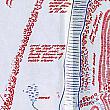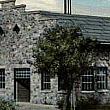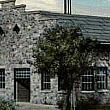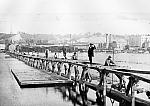
Grand Rapids Water Story, 19th Century, Part V
The Story of the Hydraulic Water Company
For more than ten years, ever since the receiver was appointed, in fact, the Hydraulic Water Company of Grand Rapids has lived from hand to mouth. Current receipts have been swallowed up rapidly by current expenses. No dividends have been paid to stockholders and no interest has been paid to bond owners. Extraordinary expenditures have been met by the issuance of receiver’s certificates. Payments on the principal of these certificates have been made only through the use of extraordinary receipts. No sinking fund could be established to meet emergencies or to pay old debts.
The average receipts of the company during the past three years, according to the reports of Receiver T. J. O’Brien, have been $15,338.92 per annum. The average expenditures have been $15,218.73 per annum. The totals from which these averages are derived include two extraordinary items, one on the receipt side for $2,044.32 derived from the sale of old 24-inch pipe, and the other on the expenditure side for $2,050.57 devoted to reducing outstanding receiver’s certificates.
Company’s Revenue from Water Rates
The company’s principal source of revenue is, of course, the sale of water. Its receipts from this sale during the past three years amounted to a total of $42,731.08, or an average of $14,243.89 per annum.
During 1903 the revenue from water rates ran higher than in any year since 1895, with the one exception of 1900. The receipts from water rates during the past nine years, together with the balances on hand at the close of each year, are shown in the following table.
|
Year |
Water Rates |
Balance |
|
1895 |
$13,543.80 |
$134.40 |
|
1896 |
13,783.75 |
361.19 |
|
1897 |
12,657.35 |
34.99 |
|
1898 |
12,199.61 |
315.83 |
|
1899 |
14,017.10 |
301.20 |
|
1900 |
15,264.71 |
273.51 |
|
1901 |
13,623.38 |
170.31 |
|
1902 |
14,393.46 |
1,192.56 |
|
1903 |
14,714.84 |
634.09 |
The rates of the Hydraulic company are the same as those charged by the City Water works department, with the one exception that the Hydraulic company charges $8 – or double the city rate – for hopper closets. An officer of the company stated that the city meter rates are too low and yield no profit.
Expenses of the Company
The principal items of expense are those for labor and coal. The average cost of labor during the past three years was $5m209.49 per year. This included office salaries and all. The average cost of fuel for the past three years was $4,968.38 per annum. Supplies for the same period averaged $511.82 per annum; boiler, repairs averaged $1,018.81; taxes average $938.26; interest averaged $510; miscellaneous expenses averaged $1,340.69. These miscellaneous expenses included rent, telephones, meters, meter repairs and so on.
In addition to the water rates the company has several minor sources of revenue, such as rent for part of the store it uses as an office, the discounts on meters, and so on.
The totals of the receipts and the expenditures are so close together that very little margin is left at the close of each year. The balance cannot be figured on to make new improvements or pay old debts.
Receiver’s Certificates Issued
The receipts and expenditures have run about the same since the appointment of T. J. O’Brien as receiver, in April 1893. Extraordinary expenditures have made it necessary the issuance of receiver’s certificates. In all $8,000 of these have been issued to pay pressing bills and make necessary repairs. Of this $8,000, the sum of $2,050.57 has been paid back. Most of the money for this purpose came from the sale of part of the 24-inch pipe that was purchased just before the appointment of the receiver. This pipe has been lying above the ground between the pumping station and the city for many years. The receiver has been authorized to sell the remaining 225 lengths and apply the proceeds upon the receiver’s indebtedness. This pipe together with that already sold, was originally worth $25,000.
Bonds Against the Company
The company has standing against it $680,000 worth of 6 per cent bonds, due in 1916. The bulk of these, it is claimed, are simply collateral for the debts of the company. A syndicate of five parties, Coffin & Stanton, S. D. Loring, Woodbury & Moulton, Elliott, Johnson & Co., and D. F. Cameron, who acted for M. R. Crow, was given $208,000 worth of the bonds to secure a loan of $108,800, made in 1889 and 18980. More bonds were given out to secure other debts. Where all the bonds are now is unknown even to the receiver.
The coupons on these bonds would, under ordinary conditions, be worth at the date about $450,000.
Interest Claim Denied
The Grand Rapids Hydraulic company, in opposing the suit brought against it in 1893 by the American Loan and Trust company of Boston, trustee for the bondholders, made the claim in its answer to the bill of complaint that it owed no interest on the bonds that were held simply as collateral. The answer reads:
“It denies that there is now due and owing to the holders of the bonds and coupons the sum of $680,000 as principal, and says that the greater number of the outstanding bonds are held as collateral for a much small indebtedness than the face of the bonds. It admits that there is now due and owing the amount of coupons which matured on July 1, 1891, and thereafter on the bonds held absolutely, but not on those held as collateral. Defendant verily believes that the coupons which it is alleged have been presented by the complainant were detached from collateral bonds, and that such coupons are not due and payable.”
Assets Far Below the Debts
Whatever may be the actual indebtedness of the company, it is very apparent that the physical assets on hand will pay only a small part of it.
These assets include the pumping station and surrounding property, the standpipe, about sixteen miles of mains, the 24-inch pipe never used and office fixtures. Then there is the franchise of the company. As to the actual value of the franchise there is much question.
When the plant was new in 1889 it was estimated by Engineer J. M. Howell, who was employed by the syndicate, to be worth about $150,000. To this may be added the value of the unsold portion 24-inch pipe purchased with the syndicate’s money, and never placed beneath the ground.
There has been deterioration in fifteen years, however. The substantial pumping station building has burned down and been replaced by a cheap structure; the machinery has undergone much wear and tear; the mains, too, have doubtless felt the effect of time and use; the well at the station certainly shows the effect of the changing years.
Most persons would call anything above $115,000 a liberal estimate of the value of the company’s material assets. The personal property assessed valuation within the city limits is $75,000. This includes the mains. The real estate valuation brings the total some thousands of dollars higher.
Grand Rapids Press, October 14, 1904
Transcribed by Rebecca Smith-Hoffman
Article posted April 11, 2014

 facebook
facebook











